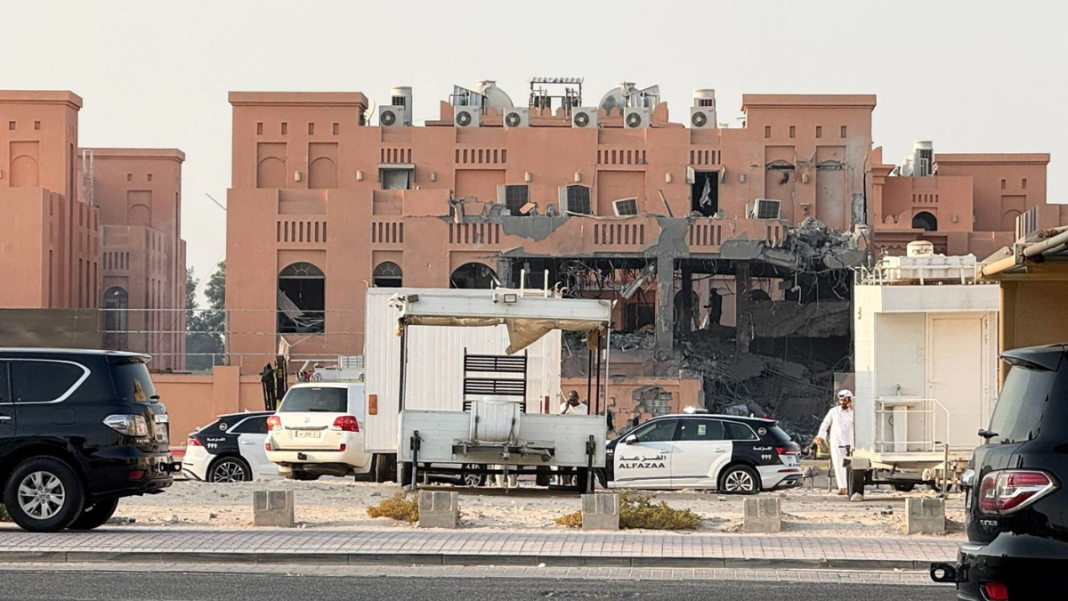A recent Israeli airstrike targeting Hamas’s political leadership in Qatar has sent shockwaves through the Middle East, raising widespread speculation about possible coordination between Israel, the United States, and Qatar. The attack, unprecedented in its boldness, struck a residential building in Doha, where senior Hamas leaders were reportedly meeting to discuss a U.S.-backed peace proposal.
The strike was carried out by 15 Israeli fighter jets, dropping multiple bombs on the building in a high-security neighborhood. The area houses schools, embassies, and is near Doha’s central business district. Despite Qatar possessing advanced air defense systems, including American-made Patriot and THAAD missiles, the attack went largely undetected. The Qatari government stated that the weapons used were “not detected by radar,” but provided no further explanation.
The incident has sparked many conspiracy theories. Some suggest the operation may have had tacit approval from Qatar and the United States. Analysts say the strike needed careful planning. It also required precise intelligence. The attackers had to know the local defense systems. Experts say it is hard to imagine the attack happening without some cooperation.
Fire from the ashes: Houthis unleash long-range missile on Israel after Sanaa airstrike kills 35
Theory 1: Qatar Turning Away from Hamas
One line of speculation suggests that Qatar may have quietly wanted to distance itself from Hamas. Since Hamas’s October 2023 attacks on Israel, Qatar has served as a mediator, facilitating negotiations and hostage exchanges between Israel and the group. However, diplomatic efforts appear to have stalled, with Hamas reportedly resisting a peace proposal backed by Israel and the U.S.
Observers argue that Qatar may have seen Hamas as a liability, shifting from a partner in negotiation to a “dead weight” that hindered its diplomatic influence. Reports indicate that Qatari officials pressed Hamas leaders to respond positively to peace proposals shortly before the strike. The timing of the attack coinciding with these meetings has fueled speculation that Qatar’s interests may have aligned with Israel and the U.S., though no evidence confirms any formal agreement.
Theory 2: Logistical Complexity Suggests Possible Coordination
Another theory focuses on the technical and logistical aspects of the strike. For Israeli jets to reach Doha, they would have had to travel nearly 2,000 kilometers over Saudi Arabia and Jordan. Such a journey would typically require airspace clearance or, at minimum, tacit acquiescence from neighboring countries.
Qatar seeks guarantees as Trump disowns Israeli strikes and vows to prevent repeat
Experts note that targeting a building in a densely populated and strategically sensitive area of Doha without triggering alarms or civilian casualties is exceptionally difficult. The precision of the strike and the lack of interference from local defenses have prompted speculation that Qatar may have turned a blind eye. Some analysts suggest the United States may have known about the operation beforehand. The U.S. has a large military presence in Qatar. This raises more questions about possible international involvement.
Theory 3: Official Response Indicates Limited Alarm
The official response from Qatar has also drawn attention. The government condemned the strike, describing it as a violation of international law, yet there was no indication of emergency meetings or immediate defensive actions. Qatar’s Prime Minister emphasized that the country would continue its role as a mediator despite the attack.
Observers describe the statement as cautious and measured, prompting speculation that it may have been intended to maintain diplomatic balance. Some analysts interpret this as further evidence that the strike might not have been entirely unexpected by Qatari authorities, fueling conspiracy theories about silent coordination or strategic tolerance.
Across the region, the event has intensified discussions about possible covert alliances and strategic decisions behind the scenes. There is no direct evidence of collaboration. But the strike’s precision and timing raise questions. Its aftermath also adds to the debate. These factors have made conspiracy theories a major part of the conversation.

